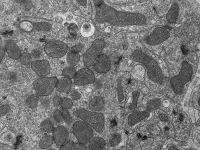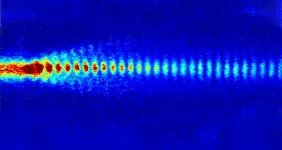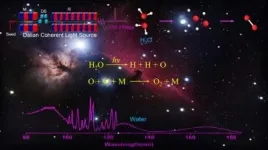DNA building blocks regulate inflammation
Shortage of DNA building blocks in the cell releases mitochondrial DNA
2021-04-30
(Press-News.org) Mitochondria are the energy suppliers of our body cells. These tiny cell components have their own genetic material, which triggers an inflammatory response when released into the interior of the cell. The reasons for the release are not yet known, but some cardiac and neurodegenerative diseases as well as the ageing process are linked to the mitochondrial genome. Researchers at the Max Planck Institute for Biology of Ageing and the CECAD Cluster of Excellence in Ageing research have investigated the reasons for the release of mitochondrial genetic material and found a direct link to cellular metabolism: when the cell's DNA building blocks are in short supply, mitochondria release their genetic material and trigger inflammation. The researchers hope to find new therapeutic approaches by influencing this metabolic pathway.
Our body needs energy - for every metabolic process, every movement and for breathing. This energy is produced in tiny components of our body cells, the so-called mitochondria. Unlike other cell components, mitochondria have their own genetic material, mitochondrial DNA. However, in certain situations, mitochondria release their DNA into the interior of the cell, causing a reaction from the cell's own immune system and being associated with various diseases as well as the ageing process. The reasons for the release of mitochondrial DNA are not yet known.
Shortage of DNA building blocks triggers inflammatory reaction
To answer the question of when mitochondria release their DNA, researchers at the Max Planck Institute for Biology of Ageing have focused on the mitochondrial protein YME1L, which owes its name to yeast mutants that release their mitochondrial DNA - yeast mitochondrial escape 1. "In cells lacking YME1L, we observed the release of mitochondrial DNA into the cell interior and a related immune response in the cells", said Thomas MacVicar, one of the study's two first authors. Closer examination revealed a direct link to the building blocks of DNA. "If the cells lack YME1L, there is a deficiency of DNA building blocks inside the cell", Thomas MacVicar describes. "This deficiency triggers the release of mitochondrial DNA, which in turn causes an inflammatory response in the cell: the cell stimulates similar inflammatory reactions as it does during a bacterial or viral infection. If we add DNA building blocks to the cells from the outside, that also stops the inflammation."
New therapeutic approaches based on the metabolism of DNA building blocks
The discovered link between the cellular inflammatory response and the metabolism of DNA building blocks could have far-reaching consequences, explains Thomas MacVicar: "Some viral inhibitors stop the production of certain DNA building blocks, thereby triggering an inflammatory response. The release of mitochondrial DNA could be a crucial factor in this, contributing to the effect of these inhibitors." Several ageing-associated inflammatory diseases, including cardiac and neurodegenerative diseases, as well as obesity and cancer, are linked to mitochondrial DNA. The authors hope that modulating the metabolism of DNA building blocks will offer new therapeutic opportunities in such diseases.
INFORMATION:
Original publication
Hans-Georg Sprenger, Thomas MacVicar, Amir Bahat, Kai Uwe Fiedler, Steffen Hermans, Denise Ehrentraut, Katharina Ried, Dusanka Milenkovic, Nina Bonekamp, Nils-Go?ran Larsson, Hendrik Nolte, Patrick Giavalisco and Thomas Langer.
Cellular nucleotide imbalance triggers mitochondrial DNA-dependent innate immunity.
Nature Metabolism, 2021.
[Attachments] See images for this press release:

ELSE PRESS RELEASES FROM THIS DATE:
2021-04-30
Scientists at the University of Nottingham have developed an ultrasonic imaging system, which can be deployed on the tip of a hair-thin optical fibre, and will be insertable into the human body to visualise cell abnormalities in 3D.
The new technology produces microscopic and nanoscopic resolution images that will one day help clinicians to examine cells inhabiting hard-to-reach parts of the body, such as the gastrointestinal tract, and offer more effective diagnoses for diseases ranging from gastric cancer to bacterial meningitis.
The high level of performance the technology delivers is currently only possible in state-of-the-art research labs with large, scientific instruments - whereas this compact system has the potential to bring it into clinical settings to improve patient care.
The ...
2021-04-30
Successful navigation requires the ability to separate memories in a context-dependent manner. For example, to find lost keys, one must first remember whether the keys were left in the kitchen or the office. How does the human brain retrieve the contextual memories that drive behavior? J.B. Julian of the Princeton Neuroscience Institute at Princeton University, USA, and Christian F. Doeller of the Max Planck Institute for Human Cognitive and Brain Sciences in Leipzig, Germany, found in a recent study that modulation of map-like representations in our brain's hippocampal formation can predict contextual memory retrieval in an ambiguous environment.
The researchers developed a novel virtual reality navigation task in which human participants learned object positions in two different ...
2021-04-30
The future of particle acceleration has begun. Awake is a promising concept for a completely new method with which particles can be accelerated even over short distances. The basis for this is a plasma wave that accelerates electrons and thus brings them to high energies. A team led by the Max Planck Institute for Physics now reports a breakthrough in this context. For the first time, they were able to precisely time the production of the proton microbunches that drive the wave in the plasma. This fulfills an important prerequisite for using the Awake technology for collision experiments.
How do you create a wave for electrons? The carrier substance for this is a plasma (i.e., an ionized gas in which positive and negative charges are separated). Directing a proton beam through ...
2021-04-30
The human immune system comprises functionally specialised cellular defence mechanisms that protect the body against disease. These include the dendritic cells. Their main function is to present antigens to other immune cells, especially T cells, thereby activating a primary immune response. Dendritic cells are divided into Type 1 (DC1) and Type 2 (DC2) dendritic cells. Each type fulfils different functions: DC1 provide an immune response to bacteria and viruses, DC2 protect against fungal or parasitic infections. In a recent study conducted at MedUni Vienna's Institute of Cancer Research, researchers found that a particular group of proteins plays a major role in the development of Type 1 dendritic ...
2021-04-30
WHAT:
In a mouse study, National Institutes of Health researchers have identified and mapped a diverse spectrum of motor neurons along the spinal cord. These neurons, which send and receive messages throughout the body, include a subset that is susceptible to neurodegenerative diseases. Created with a genetic sequencing technique, the atlas reveals 21 subtypes of neurons in discrete areas throughout the spinal cord and offers insight into how these neurons control movement, how they contribute to the functioning of organ systems and why some are disproportionately affected in neurodegenerative diseases.
The study ...
2021-04-30
Researchers have developed a brain-like computing device that is capable of learning by association.
Similar to how famed physiologist Ivan Pavlov conditioned dogs to associate a bell with food, researchers at Northwestern University and the University of Hong Kong successfully conditioned their circuit to associate light with pressure.
The research will be published April 30 in the journal Nature Communications.
The device's secret lies within its novel organic, electrochemical "synaptic transistors," which simultaneously process and store information just like the human brain. The researchers demonstrated ...
2021-04-30
The provenance of oxygen on Earth and other solar planetary bodies is a fundamental issue. It is widely accepted that the prebiotic pathway of oxygen production in the Earth primitive atmosphere was via vacuum ultraviolet (VUV) photodissociation of CO2 and subsequent recombination of two O atoms.
In contrast, the photodissociation of H2O, one of the dominant oxygen carriers, has long been assumed to proceed mainly to produce hydroxyl (OH)- and hydrogen (H)-atom primary products, and its contribution to oxygen production is limited.
Recently, a research group ...
2021-04-30
The Worldwide Innovative Network in personalized cancer medicine consortium - WIN Consortium announces the publication of the Digital Display Precision Predictor: the prototype of a global biomarker model to guide treatments with targeted therapy and predict progression-free survival for cancer patients in NPJ Precision Oncology (10.1038/s41698-021-00171-6)
Precision oncology has led to approved, molecularly specific, biomarker-defined indications for targeted therapies. With the number of validated drug targets increasing, testing each patient's tumor for all markers related to all possible targeted therapies becomes infeasible due to limited amount of tissue usually obtained by biopsies. In addition, the current companion diagnostic approach ...
2021-04-30
Targeting a pathway that is essential for the survival of certain types of acute myeloid leukaemia could provide a new therapy avenue for patients, the latest research has found.
Researchers from the Wellcome Sanger Institute found that a specific genetic mutation, which is linked with poor prognosis in blood cancer, is involved in the development of the disease when combined with other mutations in mice and human cell lines.
The study, published today (30th April) in Nature Communications, provides a greater understanding of how the loss-of-function mutation in the CUX1 gene leads to the development and survival of acute myeloid leukaemia. ...
2021-04-30
A new study finds Black patients are more likely to die after their heart bypass surgery if they're at a hospital where some care teams see mostly white patients and others see mostly Black patients. On the other hand, mortality rates are comparable between Black and white patients after heart bypass surgery when the teams of health care providers at their hospitals all care for patients of all races.
Some level of care team segregation within hospitals was very common, and the findings bring up another angle to better understand racial inequities in surgical outcomes, says co-first author John Hollingsworth, M.D., M.Sc., a professor of urology at Michigan Medicine and of health management and policy at the University of Michigan School of Public Health.
Previous studies ...
LAST 30 PRESS RELEASES:
[Press-News.org] DNA building blocks regulate inflammation
Shortage of DNA building blocks in the cell releases mitochondrial DNA






